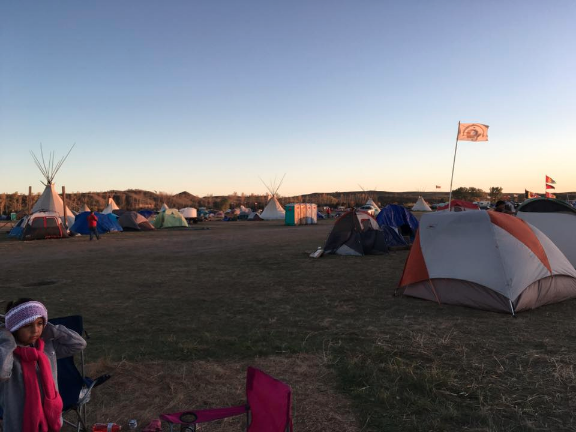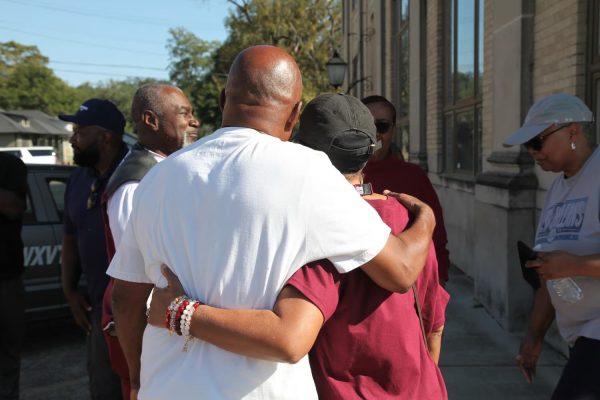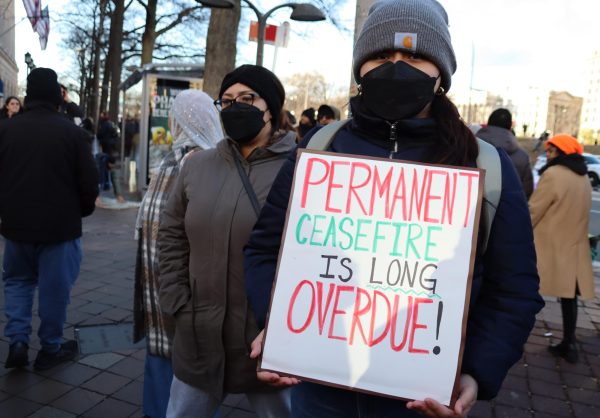Standing Together
On Sept. 28 Lauren Sargent and Terri Wilkerson, both Ann Arbor residents, loaded up a rental van full of supplies needed to survive a winter on the Great Plains and drove down to the Standing Rock Reservation in North Dakota.
The donated items worth thousands of dollars, and $1,800 of supplies Sargent and Wilkerson bought themselves, were being donated to the people camping out to help the Standing Rock Sioux tribe stop the North Dakota Access Pipeline. This 1,170-mile, $3.7 billion pipeline would transport more than 470,000 barrels of oil daily across North Dakota, South Dakota, Iowa and Illinois. It would would run beneath all privately owned land up to the Missouri River, the tribe’s main water source, crossing the river within half a mile of the Standing Rock Sioux reservation. The pipeline would put the tribe’s drinking water in danger, with the risk of leaking, which is almost inevitable. “Even though this a struggle over their drinking water for the Standing Rock reservation, they very much consider this as something that’s necessary for what they, and every indigenous culture that I know of has a way of saying the same thing, which is ‘for all my relations.’ That means all people, that means all animals, that means all plants, that means the Earth herself, that means the ancestors, and future generations,” Sargent said.
Over 300 other Native American nations from Canada to Hawaii have joined together to protest the pipeline, as well as thousands of people not of Native American descent. In addition to putting their drinking water at risk, the construction of the pipeline would also disturb burial and other sacred sites. The protesters plan to stay throughout the winter until the pipeline has been stopped.
“We shared our campsite with a homeless couple from Pittsburgh who had literally lost their home, and yet felt like this was such an important movement that they had to be there to be part of it,” Sargent said. People, like the ones she mentioned, that have flocked here, have come from all sorts of different situations and have all been united under the movement to stop this pipeline.
The camps, located both near and on the Standing Rock Reservation, follow a strict set of rules put in place by the leaders of the camps: no drugs, alcohol, and violence. If someone violates any of these they are thrown out. Sargent stresses the issue of the media spinning these peaceful protests as violent. “If you hear that, you can be sure it’s either one: a bald faced lie, or it’s the result of an agents provocateur,” Sargent said. “They are not protesters, they are protectors, that’s very different mindset.”
An agents provocateur is someone who is sent in by the opposing party to infiltrate a protest, and disrupt and discredit it using violence. This is an occurrence not so uncommon as some may think. The actions of agents provocateurs are not like the actions of those who are partaking in this movement for a good reason. “The fact that they’re escalating these tactics means that they’re on the defensive,” Sargent said. “This is guns and tanks against feathers and drums.”
Water is Life, the phrase of the movement, is an important theme at the camps. The Standing Rock Sioux are protecting their water and their way of life. They are also fulfilling an ancient Sioux prophecy which states that in the seventh generation the seven council fires of the Lakota, Dakota and Nakota Sioux will reconvene for the “saving of the world.” In the year 2016, it is the seventh generation, and the Lakota, Dakota and Nakota nations have reconvened at the Standing Rock reservation to stop the North Dakota Access Pipeline.
This ‘reconvening’ has served as a way for Native people to reconnect and celebrate their roots. Sargent describes seeing a man butchering a buffalo before dinner, just like they would have done hundreds of years ago. The days in the camps unfold respecting the native traditions. There is always a prayer at sunrise, sunset and before meals, as well as prayers, drum circles and songs throughout the day. “It’s not only non-violent, it’s also spiritual and deeply felt,” Sargent said.
High schoolers from the Standing Rock Reservation have also gotten involved, marching from their high school on a Friday afternoon, past the camps and to the front lines of protest. Peacefully, they showed their support and pride for the tribe.
With this movement being heard throughout the world, many organization have stepped in to help. The organizations on the ground supporting this movement are Greenpeace, the Indigenous Environmental Network, Veterans for Peace, National Lawyers Guild, and the American Civil Liberties Union. These organizations have put up conveniences like shower tents and solar powered cell phone charging stations. The Standing Rock tribe has also supplied amenities like handwashing stations, porta potties and firewood for the winter. But with the tribe’s resources stretched thin, these organizations and donations from individuals, like the ones Sargent and Wilkerson brought, are very welcome.
The free dinner, served to people staying at the camps, relies on the steady influx of donations. When Sargent and Wilkinson arrived, one of the first things they did was drive to the donations tent to unload the things that they had collected. Most of which was essentials needed for winter like warm sleeping bags, winter coats, snowpants, hats, blankets and items of that nature. They also brought butter, coffee and Michigan maple syrup which was immediately brought to the kitchen.
With thousands of people coming and going at the camps, the layout of the vans, tents and tepees in the camps are constantly changing, and is continuously disconcerting. One thing that Sargent stresses the camps are lacking is walkie-talkies. These four camps are located in a very remote location with no cell phone service, so communication is very difficult.
Many native people have brought their horses with them. For now, they bring their horses to the river close to the camp, once winter arrives the river will freeze over. If they decide to keep their horses at the camps over the winter, Sargent wants to get heated water troughs, with solar panels on the sides to create heat, for the winter. These cost around $500.
These protestors are here for the long run. They are already planning the construction of more permanent buildings for the winter, like a dome-like structure for meetings on the camp that’s on the Standing Rock Reservation. Even faced with arrest they don’t seem to be backing down anytime soon. The Standing Rock Sioux and everyone else who has stood with them, are not just protecting the tribe’s drinking water, they are protecting everyone who get’s their water from the Missouri River. This isn’t just a Native issue, it’s an issue of human rights.










